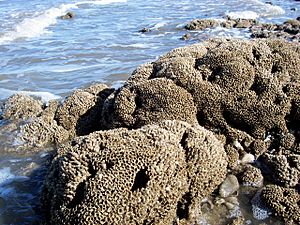List of habitats of principal importance in Wales facts for kids
Wales has special lists of plants, animals, and natural places that are super important for keeping nature healthy. Other parts of the UK, like Scotland and England, have their own similar lists.
In Wales, groups like local councils have a legal job to help protect nature when they do their work. This rule used to be part of an older law from 2006, but now it's in a newer law called the Environment (Wales) Act 2016. This new law makes sure everyone helps look after Wales's amazing wildlife and habitats.
Contents
Why We Have These Important Lists
The special lists of important habitats and species in Wales come from a bigger plan called the UK Biodiversity Action Plan (UK BAP). This plan was created to help protect nature across the whole United Kingdom.
In 2007, experts looked at these lists again. They decided to add more habitats, increasing the number from 45 to 65. The number of important species also grew from under 600 to 1,150. From these bigger UK lists, Wales chose 53 habitats that are especially important for its own nature.
Legal Duty to Protect Nature
Section 6 of the Environment (Wales) Act 2016 says that public groups in Wales must 'maintain and enhance biodiversity'. This means they have to protect and improve the variety of life around them.
Section 7 of the same Act tells Welsh Ministers to create and update lists of species and habitats that are 'of principal importance'. These are the most important ones for keeping nature healthy in Wales. This part of the law replaced an older rule from 2006.
Why These Lists Matter for Planning
Knowing about these important habitats and species is really key when new buildings or developments are planned. Local councils use these lists to decide if a new project might harm nature.
If a special habitat or species is found in an area, planners must think about how to avoid damaging it. Sometimes, they might need to change the plans or find ways to help nature instead. By doing this, they make sure they are following their duty to protect Wales's biodiversity.
Important Habitats in Wales
Here are some of the main types of habitats that are considered 'of principal importance' in Wales. They are grouped by where they are found.
Land, Coast & Freshwater Habitats
- Farm and Garden Areas: Special edges around farm fields.
- Bogs:
- Blanket bogs (large, wet areas covering hills).
- Lowland raised bogs (domed bogs in flatter areas).
- Wetlands (Fen, Marsh, Swamp):
- Lowland fens (wet, grassy areas).
- Purple moor grass and rush pastures (grassy fields with specific plants).
- Reedbeds (areas with tall reeds).
- Upland flushes, fens and swamps (wet areas in hills).
- Grasslands (Acidic): Lowland dry acid grassland (grassy areas on acidic soil).
- Grasslands (Calcareous):
- Lowland calcareous grassland (grassy areas on chalky soil).
- Upland calcareous grassland (grassy areas on chalky soil in hills).
- Grasslands (Improved): Coastal and floodplain grazing marsh (wet grasslands near coasts or rivers).
- Grasslands (Neutral): Lowland meadows (traditional hay fields).
- Heaths:
- Lowland heathland (open areas with small shrubs).
- Upland heathland (heathland in hills).
- Inland Rocks:
- Calaminarian grasslands (grasslands on metal-rich soils).
- Inland rock outcrop and scree habitats (rocky areas and loose stone slopes).
- Limestone pavement (flat, exposed limestone rock).
- Open mosaic habitats on previously developed land (mixed habitats on old industrial sites).
- Mountain Habitats: Mountain heaths and willow scrub (heaths and small trees in mountains).
- Rivers and Streams: Rivers (important waterways).
- Still Waters (Lakes, Ponds, Canals):
- Aquifer-fed naturally fluctuating water bodies (ponds with changing water levels).
- Eutrophic standing waters (nutrient-rich lakes).
- Mesotrophic lakes (lakes with moderate nutrients).
- Oligotrophic and dystrophic lakes (lakes with low nutrients or dark, peaty water).
- Ponds (small bodies of water).
- Coastal Rocks: Maritime cliff and slopes (cliffs and slopes by the sea).
- Coastal Sands/Sediments:
- Coastal sand dunes (sandy hills by the sea).
- Coastal vegetated shingle (beaches with plants growing on pebbles).
- Woodlands:
- Traditional orchards (old fruit tree areas).
- Wood pasture & parkland (areas with scattered old trees and grass).
- Hedgerows (lines of bushes and trees forming boundaries).
- Lowland beech and yew woodland (forests with beech and yew trees).
- Lowland mixed deciduous woodland (forests with various trees that lose leaves).
- Upland mixed ash woodland (ash forests in hills).
- Upland oak woodland (oak forests in hills).
- Wet woodland (forests in wet areas).
Marine Habitats (Sea and Coast)
- Coastal Rocks (Tidal Zone):
- Estuarine rocky habitats (rocky areas where rivers meet the sea).
- Intertidal boulder communities (groups of living things on boulders between tides).
- Sabellaria alveolata reefs (reefs made by honeycomb worms).
- Coastal Sediments (Tidal Zone):
- Coastal saltmarsh (grassy areas flooded by tides).
- Intertidal mudflats (muddy areas exposed at low tide).
- Peat and clay exposures (old peat or clay layers exposed on the coast).
- Seagrass beds (underwater meadows of seagrass).
- Sheltered muddy gravels (sheltered areas with mud and gravel).
- Underwater Rocks (Subtidal):
- Carbonate reefs (reefs made of calcium carbonate).
- Fragile sponge & anthozoan communities on subtidal rocky habitats (delicate groups of sponges and corals on underwater rocks).
- Tidal swept channels (channels where strong tides flow).
- Underwater Sediments (Subtidal):
- Blue mussel beds (areas with many blue mussels).
- Horse mussel beds (areas with many horse mussels).
- Mixed muddy sediments (areas with mixed mud and other materials).
- Mud habitats in deep water (muddy areas in deeper parts of the sea).
- Musculus discors beds (areas with many Musculus discors mussels).
- Subtidal sands and gravels (sandy and gravelly areas underwater).
See also
List of species and habitats of principal importance in England


